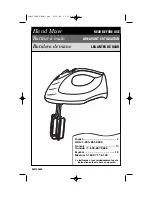
17
EURORACK MX2642A
8.6 Recording Levels
When recording to digital, its a good idea to keep the recorders peak meters below 0 dB. Most (not all, esp.
samplers) read 0 dB with some headroom left. This is because, unlike with analogue, the onset of digital
distortion is as sudden as it is horrible. If you really want to take your recording level to the limit (and fully
exploit 16-bit digitals 96 dB dynamic range), youll have to do some calibrating. How to do it? Well, you could
run a tone at 0 dB from the mixer and use that as your DAT or ADAT reference. But your DAT or ADAT may be
way under its maximum input limit. Probably a better way to work out just how hard you can drive your recorder
is to incrementally increase the record level until the onset of digital distortion, subtract, say, 5 or 10 dB, and
never exceed that level. Engage peak hold on your recorder before recording if you want to confirm that you
havent.
When recording to analogue, the tape machines VU meters should show 3 dB on bass, but only
around -10 dB for hi hat. Although analogue distortion is more like compression at modest overload levels
(often desirable on bottom end), higher frequencies cause saturation even at modest levels (an unpleasant
crunchiness). Also, VU meters tend to progressively under-read above 1 kHz, due to their sluggish response
time. Hi hats should read about -10 dB on a VU meter, as against 0 dB for a typical snare drum, and +3 dB or
more for a kick drum.
+
Peak meters read more-or-less independent of frequency. Aim for 0 dB recording level for all
signals.
8.7 Lining Up Recorder/Sampler Inputs
Set the channel sensitivity to match the operating level of your multitrack (consult the manual, phone the
manufacturer, or simply suck & see to find which setting works best). The samplers variable/switchable input
gain range is bound to accept -10 dBV and/or +4 dBu. There is no oscillator in the EURORACK, but you can
use a simple unmodulated sustained tone from a keyboard. Choose one around 1 kHz. Set the channel EQ to
normal (12-o-clock), and line up the channel according to the setting up procedures (8.2). Route this signal to
all subgroups and adjust the subgroup output faders so that the bargraph meters read 0 dB. Now put the
recorder into input mode on all channels, and the sampler into sample mode. If the tape operating level
switches are correctly set, then 0 dB on the group output meters should also show 0 dB on the tape recorders
input meters. A discrepancy of 12 dB indicates that a wrong operating level has been selected. Now adjust the
samplers input level until it also reads 0 dB.
+
Beware of inaccurafe/uncalibrated sampler input meters. Work out how hard you can safely
drive the samplers input, reference this to 0 dB on your EURORACK group (PFL). Then take
note of the samplers input gain pot setting. (Or use soft adhesive tape etc. to hold it in one
position). Now you can use the subgroup meters to confirm level when sampling, usually far
clearer than using the samplers own input level display.
8.8 Auditioning a Mix
In order to be heard other than when Solo/PFL-ed, a channel must be routed to the main mix bus. This can be
either from the channel routing matrix directly (S20), or via one of the subgroups (S18/19), so long as that
subgroup is itself routed to the L/R bus (S35). Channels going to tape are usually monitored via tape returns.
On the EURORACK this means using either input channels (stereo or mono). Stereo line inputs, or via a
separate submixer (e.g. BEHRINGER ULTRALINK PRO MX 882), patched into a suitable input such as that for
2-track playback. The MAIN MIX button of channels and subgroups going to tape should be up so as to avoid
double auditioning.
8.9 Track Sheet
When laying out channels for recording or mixing, try to be sensible. Keep tom-toms together, etc. Work out
a scheme that suits you and stick to it. A common order is: kick drum, snare, hi-hat, tom-toms (as the
audience sees the kit), cymbals (ditto), bass, guitars, keyboards, other instruments, vocals. From session to
session and gig to gig you will soon know where you are without hardly ever having to look at a tracksheet.
8. SETTING UP
Downloaded from
www.Manualslib.com
manuals search engine






































